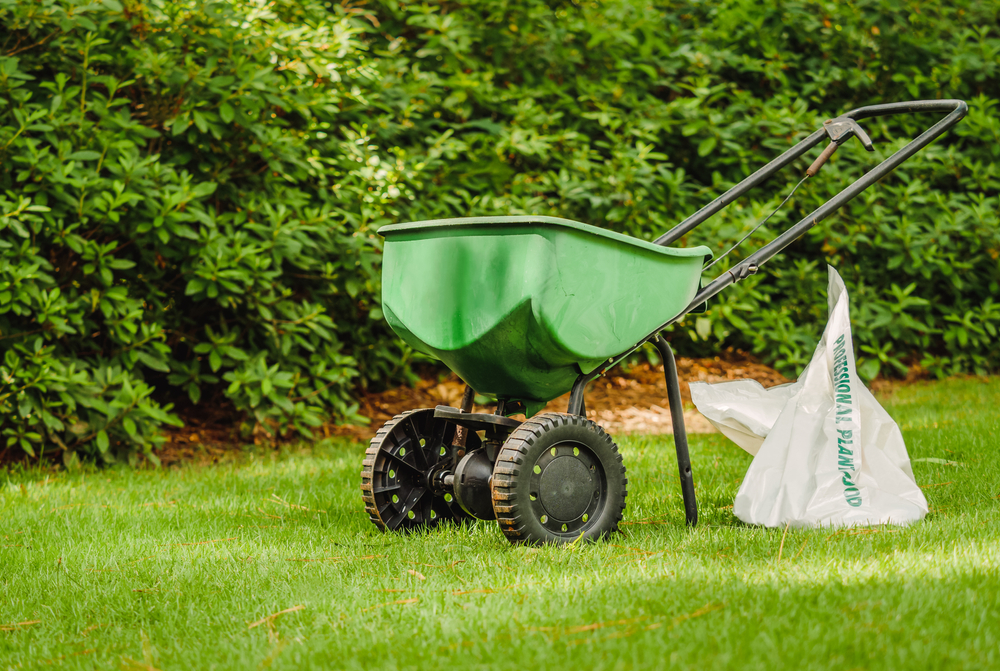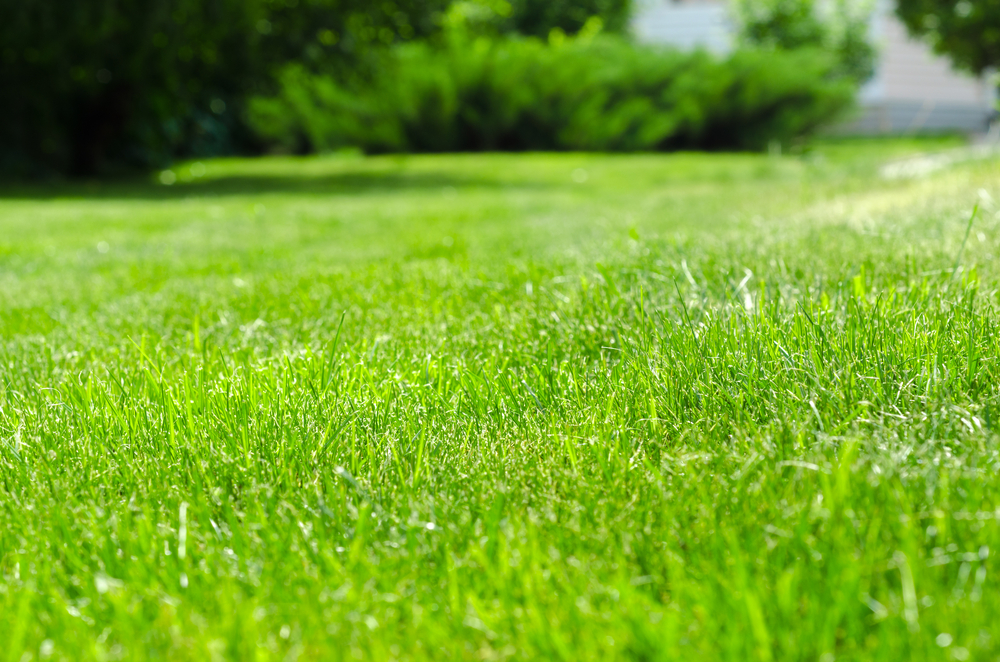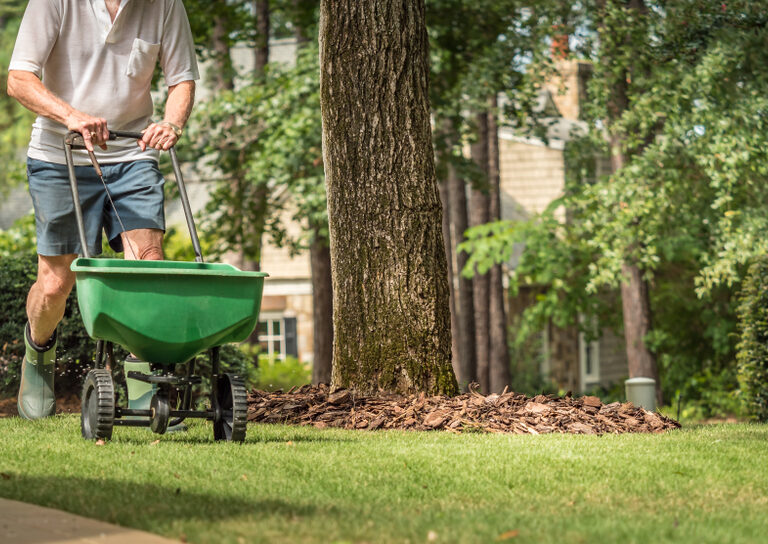We all like food. And just like all of us, grass also likes food, and it can’t survive on water alone.
That’s why it’s massively important to fertilize your lawn properly and effectively. Don’t know how to do it? Don’t know what fertilizer you should use? Don’t know how often to fertilize? In this guide, we’ve covered it all.
Here’s how to fertilize your lawn…
What You Need to Fertilize Your Lawn
First up, you need the right stuff to fertilize your lawn. If you have the right equipment, the job becomes quicker and easier, and you’ll be left with a lush green lawn (which is what you’re here for). Here are the two main things you need to fertilize your lawn:
Good Fertilizer
You probably worked this one out for yourself, you little garden detective, but you’re gonna need some good fertilizer.
You need to make sure this fertilizer is suitable for the type of lawn you have. Go to your local nursery and speak to a professional —ensure you’re buying something which is good for the grass you have, what season it is, and what you’re trying to achieve.
It’s possible to buy a good all-rounder, which is often a great solution for all but the most particular of perfectionists. That said, if you’re a perfectionist, here are the main things to consider when you’re buying a fertilizer:
NPK
A fertilizer’s NPK number refers to the mineral composition of that fertilizer. N stands for nitrogen (which promotes good green color), P stands for phosphorus (which is good for roots) and K stands for potassium (which helps battle disease).
Liquid or Solid
Consider which is best for you and your grass. Solid is hardier and more reliable, and it usually requires less applications over time. Whereas liquid is quicker and more effective, but it requires regular re-application, and it’s bad for the environment.
Synthetic or Organic
Organic fertilizer includes all types of real rotten stuff (from blood, to bone, to moss), while synthetic stuff often acts more quickly. That said, synthetics are worse for the environment, and they’re more likely to damage your grass if used incorrectly.
A Good Spreader
If you’ve gone to those lengths to get good fertilizer, you should also get a good fertilizer spreader, which allows you to feed your grass properly and evenly, and ensures that you’ll be left with a top-quality green lawn with no barren patches.
If you use your hands, you probably won’t get an even spread, even if you think you’re doing a good job.
You want to choose a spreader which matches the style, size and dimensions of your garden, so here’s an excellent guide to making sure you’re buying the right spreader for your lawn. It explains things a lot better than I could. As you’ll probably know, Scotts is the master of proper lawn care.
Here’s another excellent article featuring the best lawn spreaders 2021 has to offer. If you’re going to buy one, buy one from this list.
How to Fertilize Your Lawn

Okay, you’ve gathered your two most important pieces of equipment —now you need to get the job done. If you do it properly, and you use the good stuff we’ve outlined above, this should only take around 20 or 30 minutes on the average lawn.
Here’s our step-by-step guide to fertilizing your lawn properly:
1) Water Your Lawn
Without water, your lawn won’t accept its fertilizer. Lawns are stubborn little creatures, and they like doing things their way, so you have to play by their rules.
A few days before you’re set to fertilize, give your lawn a good watering. Make sure you use a good sprinkler. Don’t be tempted to water by hand —good lawn sprinklers water your lawn evenly and properly, making sure it’ll grow evenly and properly.
2) Approach the Edges
When it’s finally time to fertilize your lawn, start with the edges, as these are often missed out, and wind up looking bare and patchy. Good fertilizer spreaders often come with a setting that helps you to get right up to the edges.
You could also consider buying a small handheld fertilizer spreader designed with that exact job in mind.
If you don’t have a fancy fertilizer spreader with all that extra flair, you could consider doing your edges by hand, but it’s not a great idea. If you do it by hand, just make sure you’re being extra careful and attentive.
3) Hit the Middle
It’s time to go to the middle of your lawn, and finish the bulk of the job. Walk in straight, even lines, slightly overlapping each time. Imagine you’re vacuuming.
Broadly speaking, when you’re fertilizing, the most important thing is to make sure that everywhere is receiving similar, equal coverage. If you’re making sure all of your lawn is being treated consistently, you’ll get a consistent-looking lawn.
You can even make small marks on or near your grass, at either end of your lawn, to make sure you’re walking in straight lines.
4) Smile
There we go —you’re all done, your lawn is fertilized. We told you it was easy.
But the work isn’t quite over yet. First of all, you need to make sure you store your fertilizer in a cool, dry place, away from animals and kids, and then wash your hands and your fertilizer spreader.
Oh, and speaking of dogs and kids, keep them off your lawn for 72 hours after you’ve finished spreading. Lawn fertilizer can be toxic, and dangerous to animals and humans. If you’ve used organic stuff, which often includes blood and bone, your dog will probably want to run around on your lawn and eat (or roll over) all the fertilizer, so make sure you’re extra careful.
For a good visual guide on exactly how you can use a lawn spreader like a pro, this video is excellent.
How Often Do I Need to Fertilize My Lawn?
If you do it properly, as outlined above, you should only need to fertilize your lawn four times a year.
Rescuing a bare, damaged, discolored lawn is a hard job, but maintaining a beautiful one is ridiculously easy. For that reason, it’s best to fertilize properly four times a year, and you’ll never have a shoddy lawn (or need to deal with a shoddy lawn) ever again.
The four best times to fertilize your lawn are:
- Early spring, when your lawn is hungry and keen to grow.
- Late spring, when your lawn needs an energy boost after some hardcore post-winter replenishing.
- Summer, to help it withstand the constant heat and sunlight.
- Fall, to get it ready for a long winter sleep.
If you fertilize your lawn properly, it’ll obviously look good, and that’s what you’re here for. But aside from that, fertilizing keeps your grass thick, which stops it from getting sickly, and prevents the intrusion of weeds.
Basically, fertilizing is a great way to keep your lawn fully maintained, so that you’re not always battling to keep it green, full, thick, and weed-free.
Extra Tips for Keeping Lawns Looking Good

Fertilizing is the most important thing for keeping your lawn looking good. But it’s not the only thing you need to consider.
It’s also important to water your grass properly. Generally, you should give your grass around 1” to 1.5” of water per week, but you should check what type of grass you have, as different grasses have different hydration needs. You should water your lawn early in the morning if you can, which leads to less fungus, and less water lost to evaporation.
You can also use grass clippings to your advantage. You know when you mow your lawn and you have grass clippings everywhere and you need to pick them up and it’s massively irritating? Well, those clippings can actually provide useful nutrients to your lawn as they wither and rot, so you can leave them lying on your grass.
So-Lawn and Goodbye
That was meant to be a pun on “so long.” I’m sorry. I promise I tried my best.
If you follow all the help, tips, advice, and guidance above, you’ll have the healthiest, greenest lawn you’ve ever seen, drawing the envy, hatred, and questions of all your neighbors.
Want more top garden tips? On our site, we’ve got all sorts of stuff, including advice on the best string trimmers, the best weed killers, and a guide to how long it takes for grass seed to grow. Whatever you want to know about your garden, we already know it.
